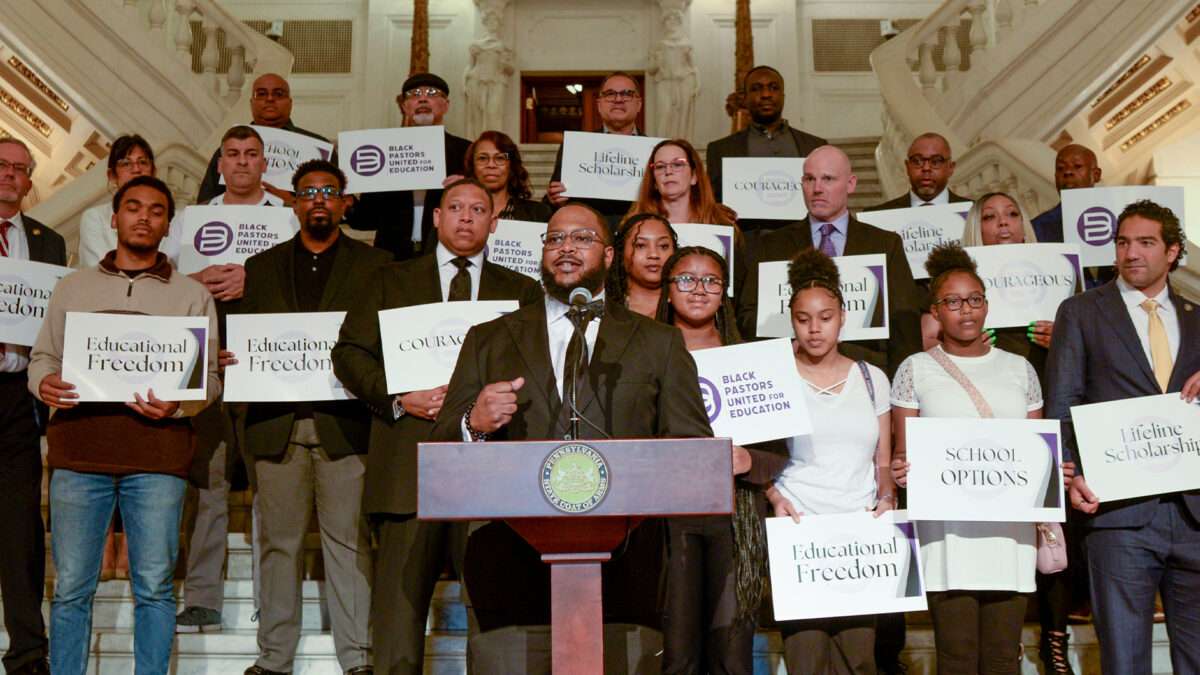A Pennsylvania Pastor Leads His Community's Fight for Educational Freedom

Pastor Joshua Robertson didn't set out to become a leader in the educational freedom movement, but when his community called, he answered.
It was several calls, in fact. In spring 2020, Robertson's phone wouldn't stop ringing. "I was receiving 40–50 calls from parents every single day," says Robertson, the senior pastor of The Rock Church in Harrisburg, Pennsylvania.
These were the early days of the COVID-19 lockdowns. The move to remote learning gave parents a closer look at their children's schooling—and they didn't like what they saw.
"All these parents were venting about the school system," Robertson recalls. "They would say to me, 'My kid is smart. I can't understand why they're not doing well academically.' Then throw in the violence in our schools. You're talking about kids who are in fistfights every other day."
Feeling hopeless, the parents turned to a different kind of teacher.
Turning Point
Our education system has significant problems, and Robertson knows it is especially tough on children in under-resourced communities like the one he serves. He had experienced the system's failures firsthand: Robertson graduated from high school without knowing how to read properly.
Robertson went to college to play football but flunked out his freshman year.
Before failing out, Robertson befriended a bishop while playing organ at a local church. But without school or sports to occupy him, he fell into a dangerous lifestyle, surrounding himself with unsavory characters and illicit behavior. As if he sensed the need to intervene from hundreds of miles away, the bishop called Robertson in the middle of one such indiscretion.
"You're about to ruin your life, aren't you?" the bishop asked. He pleaded with Robertson to come to see him. Robertson went, and the bishop enrolled them both in the local community college. The two sat side by side doing schoolwork together.
"In less than a week, he saw that I couldn't read," Robertson says. "It's amazing—you can attend twelve years of school, and no one notices that you can't read. But, because the bishop took the time to sit with me, he saw it right away. And over the next year, he sat with me day after day and taught me to read."
The man who flunked out of college because he couldn't read went on to earn both a bachelor's and a master's degree.
When the System Fails Children
"I was failed by a system, not just by a teacher," Robertson explains. "I had a few teachers who cared. But every system has gaps. And I fell into a gap."
Many educators assumed he had behavioral issues. "I was kicked out of every elementary school I ever went to," Robertson says. "What people didn't realize was that my behavior covered up my reading problems. In fifth grade, I got in trouble for hitting a kid in class. I hit him to create a diversion. The teacher was having students read aloud, and I had a feeling she was about to call on me to read."
This behavior is common among students who are left behind by the system. "They'll do something mischievous because they'd rather take the disciplinary consequence than be embarrassed in front of the whole class." Robertson says students who aren't learning well enough at school often lack any support at home, which leads to them getting into worse situations.
"They have an industry right outside their door where they can make money—the drug industry," says Robertson. "It's right on their block. I knew where people were cooking crack when I was 10 or 11 years old."
Robertson says this is where the school-to-prison pipeline begins. So he has given himself a mission: "We're trying to cut off that pipeline."
From Failure to Flourishing
Parent after parent asked him the same question: "Can my kids come to the church?"
The pastor's first thought was, "Come here for what?" Then Robertson remembered what the bishop had done for him years earlier.
"He inconvenienced his entire life in order to help me," Robertson says.
One church member had lost her job because of the pandemic, and Robertson realized she could help students with homework and provide other programming. "We took a risk and hired her," he says. "We had the facilities already with our Sunday school classrooms."
Six students from the local school district began coming to the church to do their online learning. The newly hired learning guide helped them with their homework and ensured the students sat at their computers with the cameras on when they had live lessons.
Word spread in the community. Demand continued to grow, even after schools returned to in-person classes. And so, in 2021, the Rock City Learning Center (RCLC) was born.
During the 2021–22 school year, the RCLC served 30 students—29 of whom were failing academically. By the end of the school year, 10 students finished with an average of 90 or higher across all subjects, 12 achieved an average of 80 or higher, and six finished at 70 or higher.
The following year, RCLC students saw even more significant gains. About 90 percent of the students finished with an average of at least 70, and more than half scored 90 or better.
The learning center filled in the gaps left by the system, and students who were failing are now flourishing.
A Model for Others
"These kids need an intervention—a disruption to the aspects of our schools that limit their ability to offer effective education for all students," says Robertson.
The RCLC prioritizes the student. Students receive their instruction and curriculum from an accredited public cyber charter school. They work in small pods and receive coaching from trained learning guides.
Robertson believes that the RCLC's real innovation lies in the "convergence of the academic community and the community at large." The learning guides are not educators; they are "members of the community who love our children." They provide support that extends beyond academics, customizing the experience for for each student.
When students get the support they need, they thrive. "It's incredible the confidence you see in a kid when they're loved, supported, and disciplined," Robertson says. "They understand…they're in a place that cares about them and their specific needs, challenges, and talents."
Robertson founded Black Pastors United for Education (BPUE) to help others replicate the RCLC model. Harrisburg now has three learning centers, and another opened in nearby York. BPUE was a Yass Prize finalist—a prize that honors organizations delivering "Sustainable, Transformational, Outstanding, and Permissionless education"—and received a $500,000 grant to continue advancing its work.
Fighting for Educational Freedom
In June, Pennsylvania's Democrat-controlled House of Representatives passed a bill that would cut funding to charter schools. Robertson is fighting against this effort and notes that Pennsylvania's charter schools "serve a higher percentage of low-income and nonwhite students than traditional school districts." If the bill becomes law, the hardest-hit schools would be the cyber charter schools where the RCLC students enroll.
Another goal of Roberston's political fight is a proposal for Lifeline Scholarships. This program would award restricted-use scholarship accounts to students attending Pennsylvania's lowest-performing schools. In 2023, Pennsylvania Democratic Gov. Josh Shapiro backed out of a budget deal that would have provided $100 million for Lifeline Scholarships.
On June 10, Robertson and nearly 60 other pastors and educators signed an open letter to Shapiro and the state's legislative leadership. The letter called on the leaders to oppose cuts to cyber charter schools and enact Lifeline Scholarships.
The next day, Roberston led a rally for educational freedom in the state Capitol. He also published an op-ed pleading with Shapiro to invest in educational freedom. "Today, a child's zip code determines whether she can read or perform basic math," wrote Robertson. "And this is simply unacceptable."
It has been a long journey for the pastor—from flunking out of college to leading this fight for educational freedom. Looking back on his experience, he says, "The bishop started with one person: me. And that one person he made an investment in is now making this investment in others. That's how it's supposed to work, right?"
The post A Pennsylvania Pastor Leads His Community's Fight for Educational Freedom appeared first on Reason.com.





